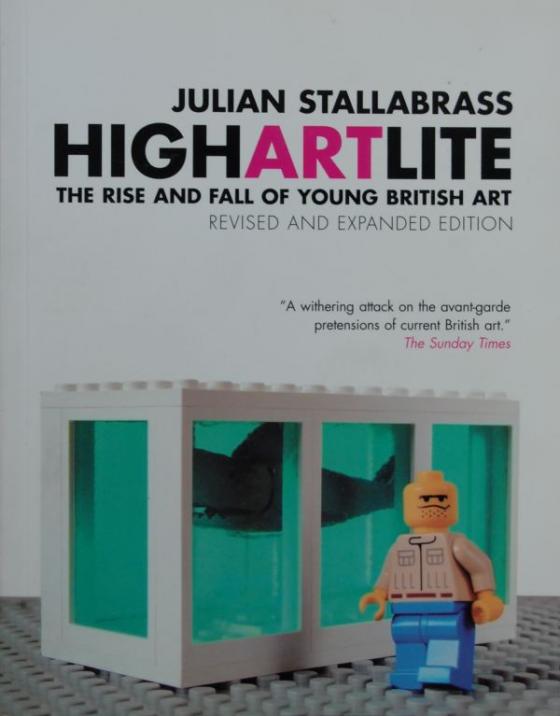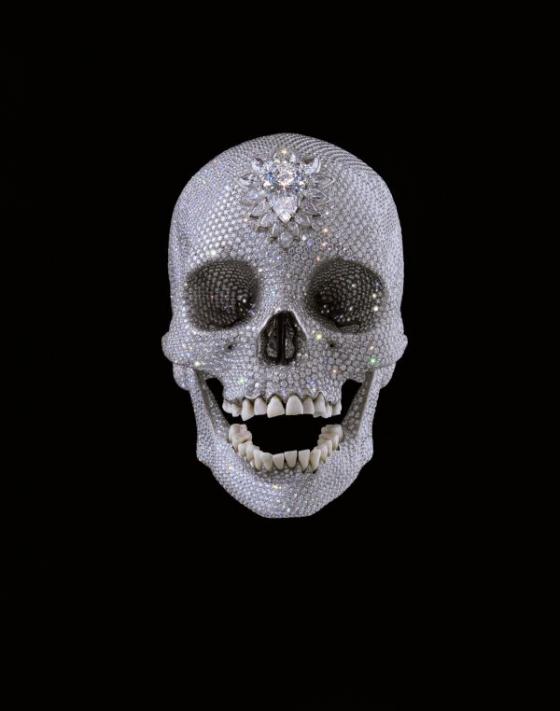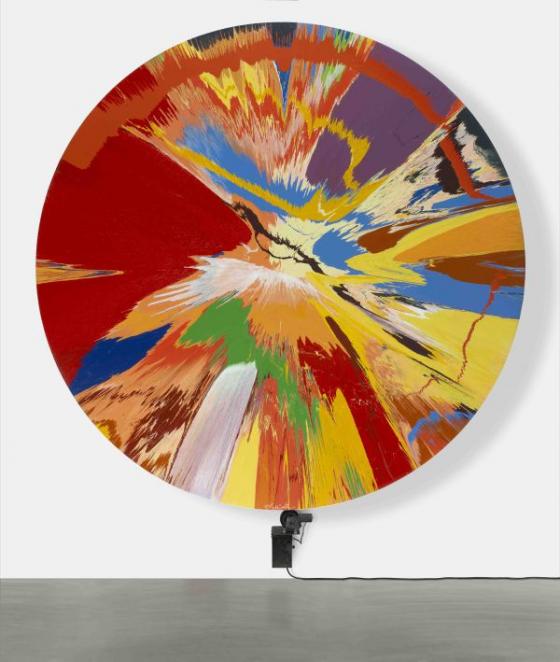Damien Hirst & Young British Art Again
Conversations with Jullian Stallabrass on YBA and with the curator Anne Galagher on Damian Hirst exhibition in Tate Modern

On Young British Art in conversation with Julian Stallabrass
Agata Mazur: For the cover of your book "High Art Lite. The Rise and Fall of Young British Art" you selected Lego versions of art works by members of YBA created by the duet The Little Artists, including Hirst's shark featured on the front cover. How does it relate to your book's intentions?
Julian Stallabrass: The book has had various covers in its different editions. The first, an image of the Chapman Brothers' child mannequins, ran into trouble with Barnes and Noble, the largest bookstore chain in the US, who refused to stock the book on grounds of obscenity. The Little Artists image is not simply belittling, but does indeed refer to the popular culture references in YBA; also because it depicts Hirst himself, and not just his shark, to celebrity and the artist-brand. Those Lego versions only work when they show something already highly recognizable.
A.M.: Growing interest in contemporary art in UK in last 20 years is partly due to artists putting together their own exhibitions in alternative spaces, the support of private and corporate sponsorships and also collectors, Tate Modern opening or establishing new awards including the Turner Prize. Some of these elements enabling the development of British art scene are criticized by you. What would the British art scene be like now without them?

Damien Hirst,
For the Love of God 2007,
Platinum, diamonds and human teeth,
© Damien Hirst. All rights reserved. DACS 2011.
Photographed by Prudence Cuming Associates
J.S.: My complaint with parts of YBA was that it had played a part in bringing a new and wider audience to contemporary art, in itself a positive matter, but didn't take that audience seriously-and that was also true of many of the critics who were most supportive of their work. YBA did not become popular because of its artist-made shows in alternative spaces; this was a tactic used by generations of contemporary artists to little public response. Popularity was due to artists, gallerists and one dealer-collector turning to the mass media to make their work widely known, along with deeper social effects (such as a large rise in those going to university) which YBA fed off but certainly did not cause. The rise of YBA took place without any significant state help (at least at home; abroad, the British Council, a part of the Foreign Office, did promote their work). The opening of Tate Modern was one of the reassertions of state cultural power that shifted the art world away from YBA.
A.M.: Saatchi's collecting on such a scale and opening a gallery to showcase the collection was a matter of huge surprise and as for UK it was quite unusual practice of that time. It enabled to change the approach to contemporary art of other British collectors as well. If we add also donations to public collections and Young Artists Sponsorship Bursaries, we will receive basically interesting ways of supporting the rice of contemporary art and artists.
J.S.: Saatchi was able to have such an effect on the British art scene for a time, partly because he bought large amounts of art by young artists cheaply during a recession in which few others were buying, but also because there were so few British collectors of contemporary art. He could not have had such an effect in France, Germany or the US where there would have been more competition. Saatchi was also unusual in running his private museum, and in dealing as well as collecting; these have become more common practices since. His recent complaint about the vulgarity and avarice of current art collectors was met with ironic laughter by those who remember his role in paving the way for them.
A.M.: "Sensation" presenting part of Saatchi's collection in Royal Academy of Arts in 1997 was visited by impressive amount of 300,000 people. It seems that increase in the popularity of gallery-going exploded owing to YBA group and its popularity, also thanks to the fact that it had "to people" attitude, which you disapprove in your book.

Damien Hirst,
Lullaby, the Seasons Spring 2002 (Detail),
Steel, glass and pills,
© Damien Hirst and Science Ltd. All rights reserved. DACS 2011.
Photographed by Prudence Cuming Associates
J.S.: I don't simply disapprove of YBA's popularity, as I've already said. The change was particularly stark in the UK because contemporary art had been taken seriously by so few people, being seen as at best arcane and worthy, at worst a laughable con. YBA helped to change that here. But in many places across the globe contemporary art has either become much more popular, or has formed in societies from which it was previously absent. One thing that I don't do in the book, but which should be done, is to see YBA within that wider global development. It's an early example of a nationally branded art tendency that is easy to market to new collectors, who may not know too much about art history, and which plays well on the global art scene, in part by ironically performing a clichéd image of their nationality. Some Polish artists have done the same.
A.M.: In the book you stress the fact that "barriers between high and low culture have apparently been breached" and art became playing similar role to the best products of mass culture. You also point out that "Museums and galleries have become increasingly run on business lines ". What would be the most reasonable relation of all these elements in your opinion?
J.S.: Art and business have moved a lot closer together, and have been doing so since the lessons of 1968 were learnt, all too well, by corporations. What was once counterculture has now become official culture, and we are all supposed to behave like artists, rebelling and expressing our subjectivity in the creation of value. Museums in the UK have been forced to operate like businesses by the lessening of public subsidy, and by state demands to appeal to wide audiences. The Tate is now a well-established brand, and that affects the art that is shown within its branded environment. Again, it is not a matter of simply saying that artists who work in this situation are to be condemned. Capitalism and commerce are inescapable for all of us. It is rather that we should not kid ourselves that art is insulated from business, and that there is a massive amount of obfuscation around the issue, designed to let art operate in its old mystifying ways, as if the old avant-garde was still in rude health.
A.M.: The chapter "Famous for being famous" begins with Damien Hirst. You claim that like in case of other members of YBA his works are a game designed to court the attention of the media. Isn't "becoming a pure brand" a sort of modern art legacy? Don't elements like artist as celebrity, using ready-mades or working with the assistants' hands seem like learning a great deal from contemporary artists such as Warhol for instance?
J.S.: Yes, of course-and also from Koons, who Saatchi showed in his gallery far ahead of any UK museum. There is a difference between making yourself an artist-brand as part of a unique social and aesthetic countercultural experiment in the 1960s and doing it now. Warhol was despised in the art world for many years for his chasing of riches and celebrity; now such behavior is one of the standard models for success.

Damien Hirst,
Sinner 1988,
Glass, faced particleboard, ramin, plastic, aluminium, anatomical model and scalpels,
© Damien Hirst and Science Ltd. All rights reserved. DACS 2011,
Photographed by Prudence Cuming Associate
A.M.:To describe art works by YBAs you use following expressions: spectacular, attention-seeking, easily affecting, trivial, pretending to make big statements, marketable naïveté, accessible, anti-theoretical attitude leading nowhere. You also compared the act of interpretation of works by YBA artists to doing the crossword - the viewer looks at the work and immediately gets the answer and move onto the next one..
J.S.: Fredric Jameson makes a useful distinction between satire and pastiche; the former contains a critique, the latter is an ironic simulation but offers no point and no alternative. Hirst, like Emin and others, made work out of an ironically constructed persona, just as Warhol did. To do so makes criticism of the work harder because interpretations can be so easily flipped between alternatives, depending on the critique offered; Hirst indeed appears to have made many of the critiques of his work himself, thus building them into the oeuvre. Whether you find Hirst's work interesting, in the end, is a matter of taste. I laid out a particular line of argument in the book, but it is offered in the spirit of conversation. It is remarkable, however, how little substantial interpretation there is about Hirst (a great contrast with Warhol here); that if there is something of interest there, its defenders have had a very hard time saying what it is.

Damien Hirst,
The Physical Impossibility of Death in the Mind of Someone Living 1991,
Glass, steel, silicon, formaldehyde solution and shark,
© Damien Hirst and Science Ltd. All rights reserved. DACS 2011.
Photographed by Prudence Cuming Associates
A.M.: You claim that YBA artists "have found something that works and they will keep doing it until it doesn't". How do you find the group today? Isn't Hirst's show to be opened soon at Tate Modern (or recent one of Emin at Hayward Gallery) a sign that they are still powerful attractors?
J.S.: It's more than a couple of years since I first wrote those lines-the book first appeared in 1999! YBA were a tendency, not a movement, and contained many different artists. Some of them I found very interesting in the 1990s, as I say in the book, and still do. The branded artists have not changed much because they are trapped by the allegorical characters they have made for themselves. So Emin has to carry on pretending to be a screwed up little girl, no matter how successful she becomes. Others, for example Mark Wallinger, always made a virtue of the variety of their work and have continued to develop and make remarkable things. Sure, quite a few of them are still popular. Hirst and Emin are more celebrities than artists, arguably, and their making of art is a side-effect of their public persona. There was a tension between the state art world and YBA, as I mentioned earlier, and it is telling that it has taken quite so long for YBA to find a home in the Tate.
A.M.:Is British art scene still centralized in London?
J.S.: London had no contemporary art museum before Tate Modern was opened in 2000, and that changed the British art scene hugely. It is no longer as provincial and inward-looking, and London has become one of the major centres of the global contemporary art world. At the same time, in a linked effect, the city has become so expensive that it does not easily sustain artists. Large numbers have moved to Berlin, to other British cities or to rundown seaside resorts. The scene is more complex, more various, more cosmopolitan, and its trends seem less separated from those seen on the art world at large. In that sense, perhaps, British art is less British-and I am not complaining about that.

Damien Hirst, Beautiful, childish, expressive, tasteless, not art, over simplistic, throw away, kid's stuff, lacking integrity, rotating, nothing but visual candy, celebrating, sensational, inarguably beautiful painting (for over the sofa) 1996
The interview with Anne Gallagher, the curator of Damien Hirst's solo show in Tate Modern
Agata Mazur: Why has Damien Hirst become one the most influential artists of his generation?
Like no other artist of his generation, Damien Hirst has permeated the cultural consciousness of our times. His work is characterised by its directness as well as its ambition; it is both deadpan and affecting, and it provokes awe and outrage in equal measure.
A.M.: The exhibition at Tate Modern will be the first substantial survey of Damien Hirst's work in a British institution. You bring together over seventy key works from over twenty years, what are the focuses of the retrospective?
A.G.: This extensive exhibition seeks to give audiences the opportunity to make a journey through Hirst's development as an artist. Bringing together for the first time the key elements of his early career, it traces the emergence of the themes and motifs that were introduced in his seminal series of works, and follows their development in subsequent transformations and incarnations. Arrangements of objects contained within cabinets and vitrines, animals suspended in formaldehyde, the life-cycle manifested by butterflies and flies, as well as sculptures featuring levitating balls, sit alongside his trademark Spot Paintings, circular canvases spun into abstraction, black monochrome paintings made from a dense mass of dead flies and vast compositions of iridescent butterflies.
A.M.: One of the artist's iconic works - diamond-covered skull For the Love of God (2007) will be shown in the Turbine Hall as an independent display and as you introduced - "a culmination of many of the themes revealed in the exhibition". What significance has this work for you as a curator?
A.G.: Hirst's art is an uncompromising exploration of the fragility of existence, using a language that pays homage to the recent history of art as well as the aesthetics of display within Western culture. For the Love of God represents the artist's continued interest in mortality and notions of value. Alluding to the iconography of the skull in art as a memento mori - a reminder of the fragility of life - the work can be viewed alternatively as a glorious, devotional, defiant or provocative gesture in the face of death itself.
A.M.: There has been always a huge controversy around YBA artists, either the audience and art critics loved it or criticised it heavily. Is the show aiming to change the negative reception?
A.G.:Throughout his career, Hirst's work has been experienced by the majority of people through the filter of photographic reproduction and headline reportage. This exhibition will be a unique opportunity for everyone to examine the works themselves at first hand and to appreciate why they became such iconic images.
A.M.: The exhibition will be accompanied by a fully illustrated catalogue by Tate Publishing. - what new can the audience expect from this publication?
A.G.: The fully-illustrated catalogue by Tate Publishing will include a new interview with Damien Hirst by Nicholas Serota, Director of Tate, and essays by curator Andrew Wilson, author and critic Brian Dillon and art historian and critic Thomas Crow, as well as shorter texts on key moments in Hirst's career by Michael Craig-Martin and Michael Bracewell.
Damien Hirst, Tate Modern, 4 April - 9 September 2012

